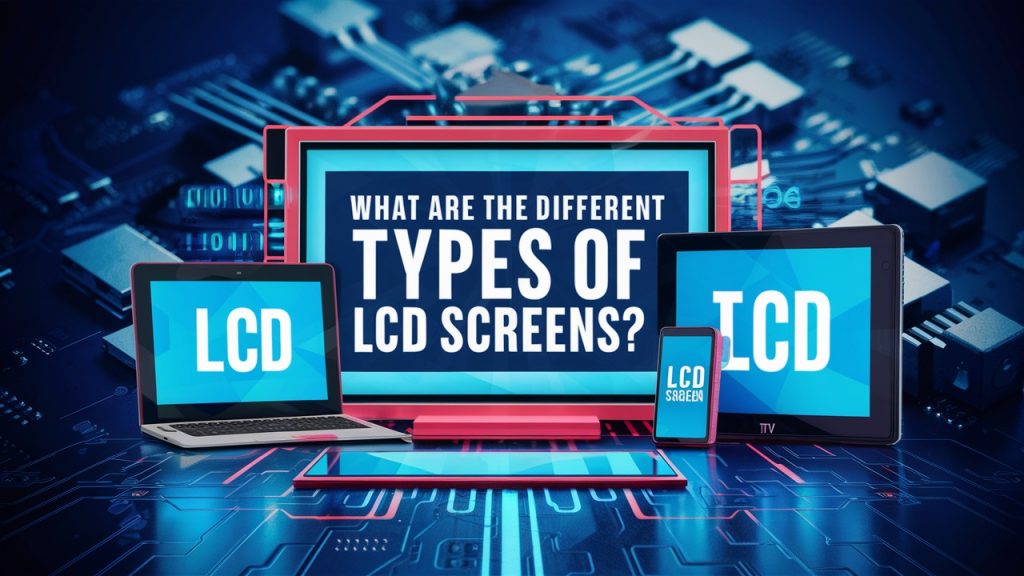LCD screens are an integral part of modern technology, found in everything from smartphones and televisions to computer monitors and digital signage. Understanding the different types of LCD screens can help you make informed decisions when purchasing or utilizing these displays. This guide will explore the various types of LCD screens, their features, and their applications.
Twisted Nematic (TN) Panels
Twisted Nematic (TN) panels are among the oldest and most common types of LCD screens. They are known for their affordability and fast response times, making them popular in gaming monitors and budget displays.
Features of TN Panels
- Fast Response Times: Ideal for gaming and fast-paced video content.
- Affordable: Generally cheaper than other types of LCD screens.
- Limited Viewing Angles: Color and contrast shift when viewed from different angles.
- Lower Color Reproduction: Not as accurate as other panel types.
Applications: TN panels are widely used in gaming monitors, budget computer monitors, and some televisions.
In-Plane Switching (IPS) Panels
In-plane switching (IPS) panels are known for their superior color accuracy and wide viewing angles. They are preferred in applications where color fidelity and image consistency are crucial.
Features of IPS Panels
- Excellent Color Accuracy: Suitable for graphic design, photo editing, and professional use.
- Wide Viewing Angles: Consistent color and contrast from different angles.
- Slower Response Times: Typically slower than TN panels, but some high-end IPS panels offer competitive response times.
- Higher Cost: More expensive than TN panels due to superior technology.
Applications: IPS panels are commonly used in professional monitors, high-end smartphones, tablets, and premium televisions.
Vertical Alignment (VA) Panels
Vertical Alignment (VA) panels offer a middle ground between TN and IPS panels, providing good color reproduction, contrast, and viewing angles.
Features of VA Panels
- High Contrast Ratios: Deeper blacks and higher contrast make them suitable for watching movies.
- Better Color Reproduction than TN Panels: Not as accurate as IPS but better than TN.
- Moderate Viewing Angles: Better than TN but not as wide as IPS.
- Balanced Performance: Offers a mix of response time, color accuracy, and cost.
Applications: VA panels are often found in mid-range televisions, monitors, and some high-end displays where contrast is a priority.
Advanced Fringe Field Switching (AFFS) Panels
Advanced Fringe Field Switching (AFFS) panels are an improved version of IPS panels, offering even better color accuracy and viewing angles.
Features of AFFS Panels
- Superior Color Accuracy: Used in environments where color precision is paramount.
- Wide Viewing Angles: Excellent consistency from various angles.
- High Brightness: Suitable for bright environments and professional use.
- Higher Cost: Generally more expensive than standard IPS panels.
Applications: AFFS panels are used in medical displays, professional graphic design monitors, and other high-end applications.
Plane to Line Switching (PLS) Panels
Plane-to-Line Switching (PLS) panels are Samsung’s proprietary technology, similar to IPS panels but with some enhancements.
Features of PLS Panels
- Excellent Color Reproduction: Comparable to IPS panels.
- Wide Viewing Angles: Consistent performance from different angles.
- Increased Brightness: Generally brighter than standard IPS panels.
- Lower Production Costs: Slightly cheaper to produce than IPS panels.
Applications: PLS panels are used in high-end monitors, smartphones, and tablets, providing a balance between quality and cost.
Super Plane to Line Switching (S-PLS) Panels
Super Plane to Line Switching (S-PLS) panels are an advancement over PLS panels, offering even better performance.
Features of S-PLS Panels
- Superior Color Accuracy: Enhanced color fidelity for professional use.
- Wide Viewing Angles: Maintains color and contrast from various angles.
- Higher Brightness: Improved brightness levels for better visibility.
- Reduced Power Consumption: More energy-efficient than standard PLS panels.
Applications: S-PLS panels are found in high-end monitors, professional displays, and some premium consumer electronics.
Advanced Hyper-Viewing Angle (AHVA) Panels
Advanced Hyper-Viewing Angle (AHVA) panels are another variant of IPS technology, focusing on providing wide viewing angles and high color accuracy.
Features of AHVA Panels
- Excellent Viewing Angles: Consistent performance from any angle.
- High Color Accuracy: Suitable for color-critical applications.
- Fast Response Times: Comparable to IPS panels, making them suitable for a variety of uses.
- Higher Cost: Generally more expensive due to superior performance.
Applications: AHVA panels are used in professional monitors, high-end laptops, and some premium televisions.
Quantum Dot LCD Screens
Quantum Dot technology enhances the color performance of traditional LCD screens by using tiny semiconductor particles that emit precise colors.
Features of Quantum Dot LCD Screens
- Enhanced Color Accuracy: Vibrant and accurate color reproduction.
- Wide Color Gamut: Capable of displaying a broader range of colors.
- Improved Brightness: Brighter images with better visibility.
- Compatibility with LED Backlighting: Often used in conjunction with LED screens for improved performance.
Applications: Quantum Dot LCD screens are used in high-end televisions, monitors, and professional displays.
Mini-LED and Micro-LED Screens
Mini-LED and Micro-LED are advanced backlighting technologies that improve the performance of LCD screens by using smaller, more efficient LEDs.
Features of Mini-LED and Micro-LED Screens
- Improved Contrast: Deeper blacks and higher contrast ratios.
- Enhanced Brightness: Brighter images with better visibility in various lighting conditions.
- Better Uniformity: More even lighting across the screen.
- Higher Cost: Generally more expensive due to advanced technology.
Applications: Mini-LED and Micro-LED screens are used in premium televisions, professional monitors, and high-end laptops.
Understanding the different types of LCD screens is crucial for choosing the right display for your needs. Whether you prioritize fast response times, color accuracy, viewing angles, or contrast, there is an LCD screen technology that suits your requirements. From the affordability of TN panels to the superior performance of Quantum Dot and Mini-LED screens, each type offers unique advantages and applications. By familiarizing yourself with these technologies, you can make informed decisions and maximize the benefits of your LCD screens.

